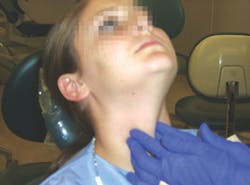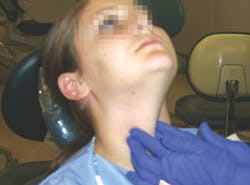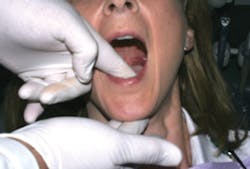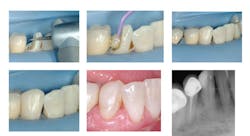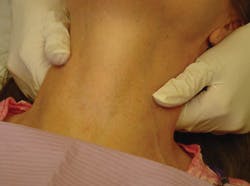The extraoral exam
by Dianne Glasscoe Watterson, MBA
Dear Readers,
When I learned this issue was to be devoted to oral cancer awareness and detection, I decided to discuss something that departs from my usual practice management advice -- the extraoral exam.
All dentists and dental hygienists learn how to perform a thorough intraoral and extraoral exam when they are in school. However, the reality is that in most offices, the extraoral exam is often omitted. Why is this? When I asked clinicians why they do not perform an extraoral exam, here are a few of the replies I received:
- I don't have time.
- I feel it is an invasion of the patient's personal space.
- I'm not really sure how to do it.
- I don't like touching patients outside their mouths.
- Patients don't understand what I'm doing.
- The doctor I work with only wants me to do intraoral screenings.
(used with permission from Dr. Nancy Burkhart)
Given the serious nature of head and neck cancer, none of these excuses is acceptable. The American Cancer Association says that more than 50% of oral cancers metastasize before they are discovered. Oral, head, and neck cancers are most common among those who smoke, chew tobacco, and consume excessive alcohol. More than 85% of head and neck cancers are related to tobacco use, while others may have a relationship to viral causes such as HPV and Epstein-Barr virus. While restorative and preventive care is important, the intraoral/extraoral exam may turn out to be the most important thing we do for patients. Just ask any person for whom cancer was detected in a dental office.
have the patient extend his or her neck by lifting the chin. Palpate bilaterally down each side of the trachea.
If you have been neglecting the extraoral exam in the past but are ready to implement this procedure now, start by informing the patient, "Mr. Smith, I'm going to perform an exam that is meant to detect any nodules or swellings that might be abnormal."
Thyroid tumors can present with the following symptoms:
- Palpable tenderness
- Deviations from the midline of the neck with asymmetry
- Nodules with a firm consistency that are fixed and nonmoveable
to the back side of the neck.
We owe it to our patients to be thorough, and the extraoral exam is an important part of excellent care. Make sure that you and your dental hygienist are providing this necessary part of the overall patient assessment.
Dianne Glasscoe Watterson, MBA, is a consultant, speaker, and author. She helps good practices become better through practical on-site consulting. Her book, "Manage Your Practice Well," is available at www.professionaldentalmgmt.com. For consulting or speaking inquiries, contact Dianne at [email protected] or call her at (301) 874-5240.
Past DE Issues
